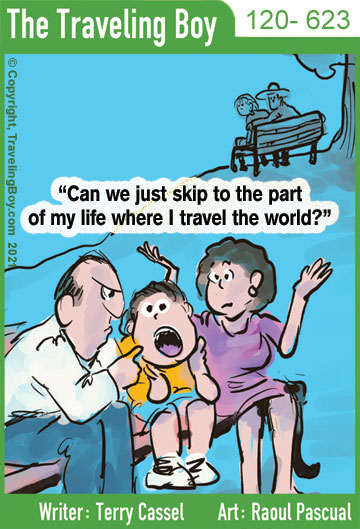10 Safety Mistakes Women Shouldn’t Make When Traveling Alone
Courtesy Caroline Morse Teel, SmarterTravel
 Solo travel can be exhilarating, freeing, and helpful in learning new things about yourself. But solo travelers, especially females, can also be more vulnerable while alone on the road. We spoke to some solo women travel experts who shared their top safety mistakes to avoid when traveling alone.
Solo travel can be exhilarating, freeing, and helpful in learning new things about yourself. But solo travelers, especially females, can also be more vulnerable while alone on the road. We spoke to some solo women travel experts who shared their top safety mistakes to avoid when traveling alone.
Arriving in a New Location During Off Hours
Taking a flight that gets in at 3:00 a.m. may be cheaper, but do you really want to arrive in an unfamiliar city for the first time when the streets are dark and empty? Janice Waugh at Solo Traveler says, “Arriving in daylight makes it easier to find your accommodation and gives you time to change it if you find that it is unsuitable.”
Dressing Inappropriately
Choose your outfits wisely, and try to err on the side of conservatism. Research your destination and find out if it’s taboo to have uncovered shoulders, etc., and dress appropriately. Not only will you be showing respect for other cultures, but you’ll be drawing less attention to yourself by blending in.
Not Having a Backup Plan
The late Evelyn Hannon, founder of Journeywoman, told SmarterTravel, “It’s very important [for me] to have a good backup plan if I am robbed or if I lose my credit cards. Here is one of my best tricks. Save your empty vitamin pill bottles; generally you can’t see through these. Roll up five $20 bills, put them into the bottle, and add some old loose pills. If you shake this bottle it still sounds like a pill bottle and nobody would consider looking into it for money. You can leave this bottle in your backpack, your hotel room or in your cosmetic case. The contents remain safe and ready for you should you need it.” Also, be sure to scan a copy of your passport and other important documents and email them to yourself. This way you’ll have access to your information in case it’s stolen.
Assuming Other Women Are Safe
Janice Waugh writes, “Women often feel safer with other women. And, when it comes to small-time danger, we probably are. But there are also dangerous women who are just as capable of luring you into bad situations as men. Be cautious.” Of course, this doesn’t mean that you shouldn’t make new friends on the road — just be alert for potential scams and dangers, especially when you first meet someone.
Telling People Where You’re Staying
Whether you’re filling out a form that asks for the address of where you’re staying, asking for directions, or just making conversation, be sure to guard the location of your accommodation from prying eyes. Try not to let on that you’re staying alone, as well. (Hey, we’ve all seen Taken, right? Never share a cab to a hotel with a stranger either!)
Taking an Unlicensed Cab
Taxis have licenses for a reason — you’re getting into a car alone with a stranger. Don’t be tempted by illegal cabs, even if they’re cheaper. Ask your hotel to hail or call you a cab when going out, and ask the concierge for the number of a reputable agency you can call to take you home. If you’re using a ride-sharing company like Uber or Lyft, always check the license plate number and confirm the name of your driver before getting in the vehicle.
Wearing Flashy Jewelry
Sure, you want to look cute while on vacation. But leave the shiny stuff at home — even if it’s costume jewelry. You don’t want to seem like a wealthy target.
Answering Your Hotel Door
Whether it’s someone claiming to be hotel maintenance, room service (that you didn’t order), or even housekeeping, don’t open your hotel door when you’re alone in the room (especially without checking the peephole first). If there’s someone telling you about an emergency or a maintenance issue and they need access to your room, call down to the hotel’s front desk to verify their story.
Accepting Food/Drink from Strangers
“Accepting food from strangers is not always the right thing to do,” says Hannon. “Picture this. You are traveling solo on an overnight train in Europe. The young couple seated beside you are very chatty and offer lots of good advice about what to do at your destination. They unpack a wonderful picnic of sausage, cheese, fresh bread, and wine. The aromas are so enticing, they offer to share their food and wine. You’re thinking, ‘This is what European travel is all about.’ Again, evaluate very carefully before you partake. Understand that drugging is always a possibility. You don’t want to wake up to find your friendly neighbors gone along with all your belongings.”
Letting Fear Hold You Back
We’re not trying to scare you off solo travel. Just be careful. Laura Walker from A Wandering Sole says, “Do your research and don’t be afraid to engage locals. People were worried when I told them I was going to Jordan and Rwanda. Jordan happens to be one of the safest countries in the world and is safer than virtually all large cities in America. Rwanda also is extremely safe and I never felt in danger in either of these countries. Don’t get me wrong, I take standard precautions, but I don’t let fear or inaccurate information prevent me from traveling and enjoying myself. Do your research and go with an open mind. I have found that locals want you, as a visitor, to enjoy their country, and you should ask them for the most up-to-date information on any safety issues.”
France’s Fascinating ‘Wine Treatment’
Courtesy Melissa Banigan
In Strasbourg’s Hôpital civil, a bottle of Châteauneuf-du-Pape would be prescribed for bloating, while a Côtes de Provence rosé was used to treat obesity.
The father of medicine, the Greek physician Hippocrates, experimented with a number of wine varietals to treat various ailments, believing that, “Wine is an appropriate article for mankind, both for the healthy body and for the ailing man.” In modern times, we’re generally taught to drink in moderation, but in France, which traces its viticulture back to the 5th Century BCE, ‘à votre santé’ – or ‘to your health’ – was a toast that still rang true until the turn of the 21st Century.
To learn more about France’s deliciously incestuous relationship between wine and medicine, I needed to visit a wine cellar deep in the bowels of a medieval hospital in Strasbourg, located in the Alsace region of eastern France.
Strasbourg, a modern city with a 2,000-year history, is perhaps best known for its centre (the Grande-Île), which was listed as a Unesco World Heritage site in 1988. Travellers flock here to wander through its world-famous Christmas market, Cathedral Notre Dame and Palais Rohan, as well as to dine in typical Alsatian winstubs (wine restaurants) such as Restaurant Chez Yvonne or Maison Kammerzell, which sits in a building dating 1427.
But I was heading to the Hôpital civil de Strasbourg, a teaching hospital that was founded 1119. On that late, rainy evening, the streets were empty, and as I walked over the wet cobblestones with two companions, it was easy to imagine what the city might’ve looked like hundreds of years ago.
Since 1395, the Hôpital civil de Strasbourg has had a symbiotic relationship with the Cave Historique des Hospices de Strasbourg (Historic Wine Cellar of Strasbourg Hospices), which lies directly beneath the hospital: one literally wouldn’t exist without the other. For around 600 years, many of the hospital’s patients paid their medical bills with tracts of vineyard – and the grapes grown on these newly acquired lands were then made into wine in the cellar. This was a common practice in France, as the vineyards provided income for the hospitals; and the cellars – which functioned as large refrigerators – were the perfect places for keeping wine cool.
People from all over France came to the hospital to receive ‘wine treatments’, which were exactly what they sound like: up to two bottles a day of wine to treat various ailments.
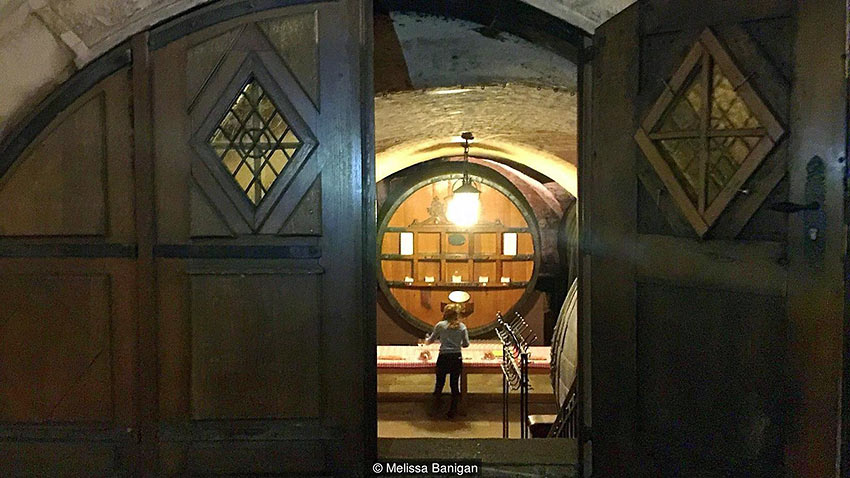
Although wine treatments were ubiquitous in ancient times, Thibaut Baldinger, the manager of the cellar who had graciously agreed to stay late to give my companions and me a tour, said that he had seen proof that wine had been used as medicine since the 1960 – and that the treatments weren’t stopped until 1990.
A bottle of Châteauneuf-du-Pape, for example, would be prescribed for bloating, while a bottle of everyone’s summer favourite, Côtes de Provence rosé, was used to treat obesity. High cholesterol? Just two measly glasses of Bergerac. For herpes, patients were told to bathe in a lovely Muscat de Frontignan. Trouble with your libido? Six dreamy glasses of Saint-Amour purportedly lubricated ailing lovers into Casanovas in no time at all – interestingly, two fillettes, or carafes, of this wine were also said to work for maladie de la femme (women troubles).
“What about the liver?” I quipped? Baldinger laughed: “Some treatments perhaps worked better than others.”
I did later note, however, that the list of wine treatments included three entire bottles of Beaune Eau Gazeuse (Beaune wine mixed with sparkling water) for ‘cirrhose’, leading me to believe that at least one person from modern history believed inebriation to be an antidote to liver failure.
Although the hospital’s wine treatments ended several decades ago, the cellar continues to play an important role in France’s winemaking history by continuing to showcase some of France’s finest wines while financially supporting the hospital. In 1995, however, the 600-year-old cellar was nearly relegated to history books for what Baldinger called a “lack of profitability”.
Over the 20th Century, the hospital sold off tracts of vineyards to finance certain hospital projects that required immediate attention, effectively stemming the supply of grapes to the cellar. The cellar was then forced to abandon its giant oak wine barrels after new French law – the Loi Évin – was passed in 1991. The law had strict provisions meant to prevent alcoholism, which meant the government no longer looked kindly upon booze in the basement of an établissement de santé, or health facility.
Baldinger’s predecessor, Philippe Junger, became the de facto defender of the cellar by rallying the support of Alsatian wine growers and creating the Society of Agricultural Collective Interest (SICA). The collective found ways to convince lawmakers to keep the cellar open by arguing its importance as part of the region’s heritage.
Successfully saving the historical site, dozens of Alsatian vineyards began working to improve their wines under the watchful eye (and nose) of Junger and the cellar’s oenologists. Since 1996, a competitive blind tasting has been conducted every January: any wine that doesn’t make the cut is booted from the cellar.

Today, the cellar produces 140,000 bottles of Gewürztraminer, Klevener de Heiligenstein, Sylvaner and Riesling per year, using grapes grown by 26 different wine partners. The wines are aged for six to 10 months in mammoth oak barrels before being bottled and sold to the public. Amazingly, the cellar does no advertising of any kind and has only a website. “Every wine-making partner gives a small percentage of his production to the historical cellar shop, as rent,” said Baldinger. The proceeds from the cellar’s portion of the production are invested into the purchase of medical equipment for the hospital, while the partners benefit from the lion’s share of the wine.
There are some wines in the cellar that are never sold. Baldinger pointed to a small cabinet adhered to the cellar’s stone wall. Inside the dimly lit case was a skull and a clear bottle of wine – the liquid inside discoloured by age to rust-red, like dried blood – on which was written a date: 1472. “There’s some speculation that the skull belonged to Mister Arthur, the first cellar master. He might’ve had too much of the wine,” Baldinger said.
And the story of this rust-red wine – the first produced by the cellar? “I’ll show you,” replied Baldinger, leading us away from the case and between two rows of giant oak barrels. There, an old, imposing iron gate separated the cellar from a storage area, in which sat about half a dozen smaller, older oak barrels. Baldinger pulled a large skeleton key from his pocket and opened the gate to where the cellar’s Vin Blanc d’Alsace (White Wine of Alsace), what is believed to be the world’s oldest barrel-stored white wine, is kept.
Baldinger explained that this wine has only been tasted three times: The first was in 1576, when the inhabitants of nearby Zürich (more than 200km to the south-east) shipped a giant kettle of porridge to Strasbourg to show that the city would provide assistance if there were ever a need. In less than 24 hours, the porridge arrived, still warm. Baldinger says that Strasbourg responded in kind by uncorking the city’s fabled wine and giving some thirsty Zürichers a sip.
The second tasting was in 1718, during the reconstruction of the hospital following a devastating fire, when the pharmacy (which 200 years ago was a bakery), the Protestant chapel and the wine cellar were the only buildings not affected by the disaster. “A phial containing the wine from 1472 was symbolically set down into the first stone of the new building and, on this occasion, the wine was tasted for the second time,” Baldinger explained.
The final time the wine was drunk was in 1944. During World War Two, the cellar had operated under Nazi control (who, according to Thibaut, filled most barrels with their favourite wine: Bordeaux). After the end of the war, just after the liberation of Strasbourg, General Leclerc (who would later become Marshal of France) took a celebratory sip of the vintage.
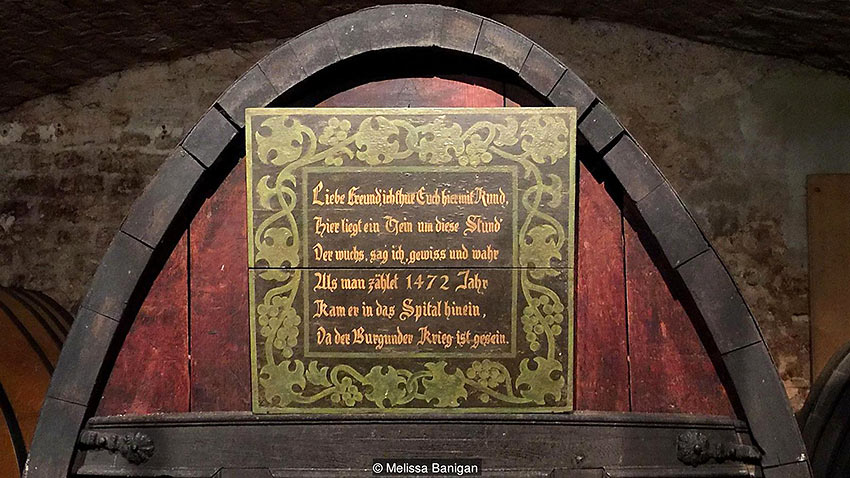
Most visitors to the cellar aren’t even allowed past the gate, but perhaps sensing our enthusiasm, Baldinger asked if we wanted to smell the cellar’s crown jewel of wine. Bien sûr, we replied.
Baldinger reached up to the top of the oak barrel and gently jostled the cork until it came loose. Slowly, he waved the cork beneath our nostrils, allowing the wine’s bouquet to hit our olfactory organs.
Cognac. I’m no trained sommelier, but similar to French brandy, the wine smelled jammy, a little pruney, with hints of vanilla as well as what reminded me of my grandfather’s old cigar box.
“It smells lovely,” I said hopefully. “Perhaps just a little sip?”
Baldinger shook his head. The pH level of the wine, he said, is now 2.28 – far too acidic to drink without causing a sour stomach (most white wines have pH levels higher than 3.0).
Not all the wine contained in the barrel was produced in 1472, however. “We add wine each time the cork is dry,” Baldinger said. “Four times a year, about four to six litres are added to the original 400 litres. We select a Riesling or a Sylvander that has aged in our cellar.”
And the original grapes used in the wine? “Unfortunately, we don’t know,” Baldiner said. “There’s been a lot of mutation over the years, and a lot of mixing of grapes in the vineyards.”
I sighed while watching Baldinger recork the barrel – I would have been willing to suffer a temporary upset stomach just to be able to say I had tried that special wine. Besides, shouldn’t there be a wine treatment for such an ailment?
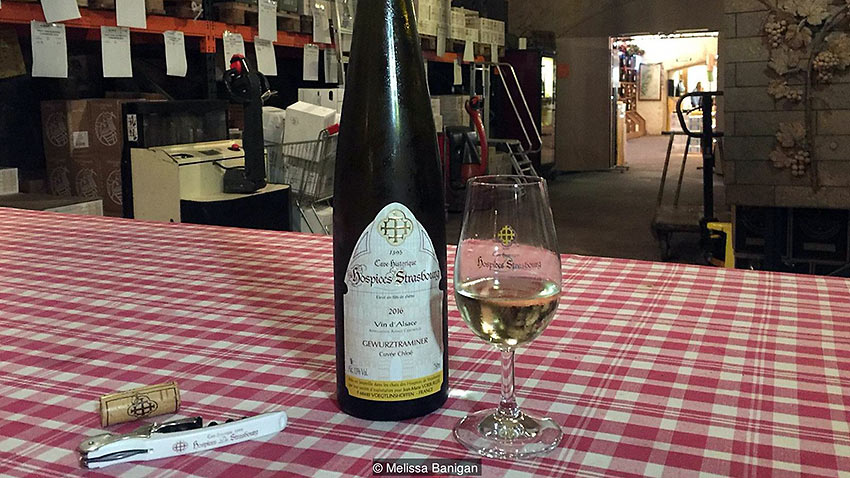
Fortunately, there were plenty of other vintages to taste. Baldinger uncorked a bottle of Gewürztraminer and gave each of us a healthy pour. We sat for a few minutes around a table with a red-and-white checked tablecloth and took a sip: sweet, with a bouquet of lychees, it was both delicious and fortifying on such a damp, rainy night – in fact, up until 1990, two glasses of the stuff were used to treat infection.
So, as we left the cellar, I bought a bottle of the Alsatian ‘medicine’ to gift to my family for their medicine cabinet – or dinner table – back home.
Puerto Rico Tops the List Of Most Popular Flight Destinations From the USA
New data obtained by a flight-comparison site has revealed the most popular flight destinations searched for from the USA, with the San Juan Luis Muñoz Marin Airport in Puerto Rico emerging as the most popular destination for 2019.
The most searched for destination for visitors from outside of the USA was found to be New York City, followed by Miami and Orlando, whilst the most popular domestic flight routes around America were found to be between New York and Miami, and New York and Orlando.
The data was compiled by the team at flight-comparison site www.us.jetcost.com who analysed the number of searches onsite from American airports to destinations abroad between the 1st January and 19th May 2019.
The most searched for foreign* destinations from United States airports were found to be:
- San Juan Luis Muñoz Airport, Puerto Rico – 248,220 (searches for flights to this airport from inside the USA)
- Santiago de los Caballeros, Dominican Republic – 222,136
- Havana, Cuba – 194,887
- Santo Domingo, Dominican Republic – 149,887
- Guadalajara, Mexico – 125,350
- Mexico City, Mexico – 119,764
- San Salvador, El Salvador – 65,400
- Holguín, Cuba – 63,453
- Cancun, Mexico – 52,202
- Santa Clara, Cuba – 50,434
Also found as part of the study were the most popular US cities to fly to from outside of the States, with the top 10 found to be:
- New York City – 421,472 (searches for flights to this airport from outside of the USA)
- Miami – 381,517
- Orlando – 142,135
- Los Angeles – 100,526
- Chicago – 62,632
- Boston – 54,888
- Washington – 53,151
- Houston – 50,727
- San Francisco – 43,312
- Atlanta – 40,956
What’s more, the most popular domestic routes were found to be between New York and Miami, and New York and Orlando, with the complete top 10 most searched for routes below:
- New York to Miami – 55,596
- Miami to New York – 40,688
- New York to Orlando – 30,536
- Orlando to New York – 15,704
- Washington to Miami – 14,119
- New York to Los Angeles – 13,123
- Chicago to Miami – 12,867
- Houston to Miami – 12,845
- Atlanta to Miami – 12,730
- Philadelphia to Orlando – 11,557
Commenting on the findings of the study, a spokesperson for www.us.jetcost.com, said:
“It was interesting to see that the top 10 searches for flights from the USA were exclusively to destinations in Central and South America, showing that Americans generally prefer to vacation close by. Unsurprisingly, New York was the most popular destination for tourists into the States, although it was interesting that Miami was the second most searched for, despite being far less busy.”
*Foreign in this case refers to destinations not recognized by the site as a USA IATA, and are airports that are not on the mainland of the United States
Chinese Tourism to US Declines For First Time in 15 Years
Data from the National Travel and Tourism Office found travel from China to the U.S. fell 5.7 percent in 2018 to 2.9 million visitors. It marked the first time since 2003 that Chinese travel to the U.S. slipped from the year prior, The Associated Press reported.
The trade war between the U.S. and China could be one of the contributing factors of the tourism drop. The U.S. now has a 25 percent tariff on $200 billion worth of Chinese imports, while China has retaliated with tariffs on $60 billion of U.S. imports.
Another reason for the decline could be in wake of China issuing a travel warning for the U.S. last summer, telling its citizens to beware of shootings, robberies and high costs of medical care. The U.S. later struck back by issuing a warning to Americans about travel to China.
Another possible reason behind the tourism decline is economic uncertainty in China, which is leading many citizens to either travel closer to home — like to Hong Kong, Macau or Taiwan, for example. Those who do travel may be seeking out more exotic destinations like Croatia and Nepal, according to Wolfgang Georg Arlt, the director of the Chinese Outbound Tourism Research Institute said.
Chinese travel to the U.S. has been leveling out after it boomed earlier in the decade. In 2000, 249,000 Chinese visited the U.S. That number tripled to 802,000 by 2010, then tripled again by 2015, in part because of higher incomes, better long-haul flight connections and an easing of visa restrictions, according to consulting firm McKinsey.
In 2016 and 2017, more than 3 million Chinese visitors came to the U.S., but year-over-year growth edged up just 4 percent in 2017 — the slowest pace in more than a decade.
Most industry-watchers agree that any downturn is temporary, since China’s middle class will only continue to expand. The U.S. government forecasts Chinese tourism will grow 2 percent this year to 3.3 million visitors, and will reach 4.1 million visitors in 2023.
Overall, international travel to the U.S. has decreased.
Data for 2018 hasn’t been released yet, but international travel to the U.S. fell 2 percent in 2016 and was flat in 2017. However, Chinese travelers contribute to the highest tourism traffic to the U.S. and any decline will be felt by destinations that have relied on the Chinese spending power.
Spending by Chinese visitors – which doesn’t include students – has increased more than 600 percent between 2008 and 2016 to nearly $18.9 billion. To hold on to that money, experts said the U.S. tourism industry must do more to keep up with Chinese travelers and their changing needs.
Customer Satisfaction in Airline Travel
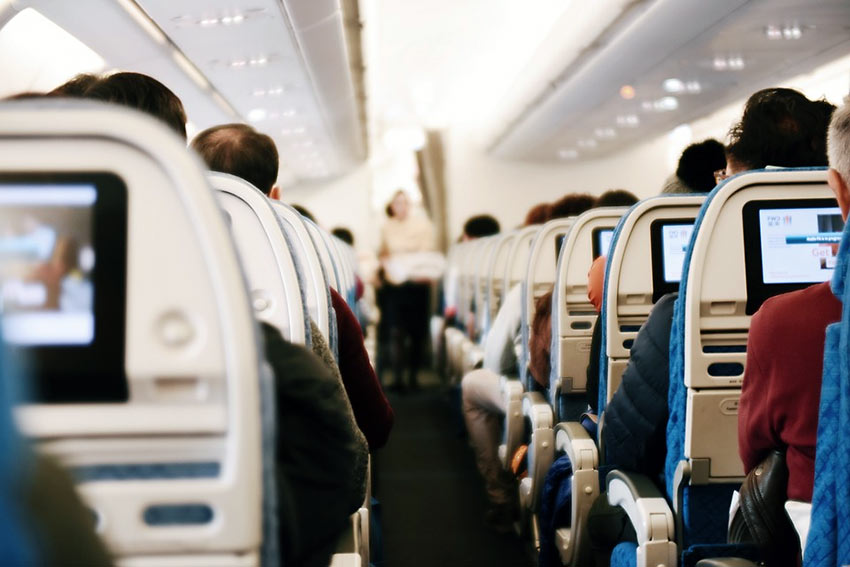
A combination of newer planes, better ticket value, and improved customer touchpoints have driven overall satisfaction with airlines to its highest point in history.
Following are some of the key findings of the 2019 study:
- Record-high customer satisfaction: Overall satisfaction with airlines increases 11 points to 773, continuing an eight-year trend of satisfaction improvement.
- Improvement driven by traditional carriers: This year’s significant gains in customer satisfaction are driven by the traditional carriers, whose segment satisfaction score improves 22 points from 2018. The low-cost segment — while still having higher overall satisfaction than the traditional carrier segment — declines 6 points from 2018, thus driving a segment convergence in satisfaction.
- Tech investments in reservation and check-in systems pay off: The reservation and check-in experiences are the most satisfying portions of the airline experience, driven by investments in digital check-in technologies, self-service kiosks and a concerted effort among airlines to improve the efficiency of the pre-flight process.
- In-flight service remains a stumbling block: In-flight services, such as seatback entertainment, food service and Wi-Fi continue to be the lowest-ranked part of the air traveler experience. Specific in-flight amenities that have the greatest positive effect on customer satisfaction are fresh food, seatback games and seatback live television.
Among traditional carriers, Alaska Airlines ranks highest for the 12th consecutive year, with a score of 801. Delta Air Lines (788) ranks second and American Airlines (764) ranks third. For low-cost carriers, JetBlue Airways (817) and Southwest Airlines (817) rank highest in a tie. For Southwest, this is the third consecutive year at the top of the J.D. Power ranking.
Best Obscure French Gastronomic Restaurants
Courtesy Anthony Peregrine, The Telegraph
Here are six slightly obscure French destinations with a surprising number of gastronomic restaurants.
1. Kaysersberg (pop: 2,700)
Alsaciens exact high standards – in the kitchen as elsewhere. Olivier Nasti meets them to two-star Michelin level at the grand Chambard hotel. Thus is Kaysersberg becoming the pint-size culinary hotspot of this outstanding region. Alongside the posh dining (lechambard.fr, £160 for a full tasting menu), Nasti has a winstub brasserie operation doing Alsace specialities (choucroute, baeckeoffe, foie gras) with panache. And alongside both are other standout restaurants. Don’t miss the family-run Vieille Forge (vieilleforge-kb.com, menus from £27) or Jérôme Jaegle’s L’Alchémille (lalchemille.fr, menus from £28).
Stay at: The Chambard, which is also a four-star hotel, in 18th-century surroundings, room-only doubles from around £170.
2. Noirmoutier (pop: 9,600)
First time I crossed the causeway to Noirmoutier, someone had just stolen all the CDs from my car. So it was without Tina Turner that I arrived on the island off the Vendée coast. The compensations were almost adequate. Head first for La Marine on the port at the L’Herbaudière, the isle’s western tip. Alexandre Couillon’s modern way with fish has winched it to two Michelin star status (alexandrecouillon.com, nine-course menu costs £154). Nearby, Le Grand Four has been surging ahead since Henrick Garriga and José Roche took it over a couple of years ago (legrandfour.com, £29). And the Fleur de Sel remains the island’s classic address (fleurdesel.fr, £26).
Stay at: The Fleur de Sel: doubles from around £100 b&b.
3. Cancale (pop: 5,200)
I’d finished the fish soup, they brought me the homard and I said: “The world is my lobster.” I’d waited long for the right place in which to echo Arthur Daley. Cancale is that place. Near St Malo, it’s hemmed with some of France’s finest oyster beds. And it has as much terrific eating as any Breton needs. Olivier Roellinger led the town to prominence with his Michelin three-star Relais Gourmand. He’s shut it now, for the simpler life at Le Coquillage (within the Château Richeux; maisons-de-bricourt.com, £62). Not far away, at St Mélior-des-Ondes, the Maison Tirel-Guérin is reliability in restaurant form (tirel-guerin.com, around £40pp). Meanwhile, Franco-Japanese Raphaël-Fumio Kudaka runs a top-class eatery above the Breizh Café créperie on the Cancale waterfront (breizhcafe.com, from £65 for a set menu).
Stay at: The old-fashioned Tirel-Guérin, room-only doubles from around £105.
4. Blois (pop: 46,000)
The château of Blois – in the Loire valley – offers a brilliant trot through a fine slice of French royal history. The nocturnal son-et-lumière is less riveting. I’d have been better lingering over dinner, especially as Blois is becoming a regal cuisine centre. Assa is so in the vibe of Franco-Japanese fusion that Fumiko and Anthony Maubert bagged a Michelin star a couple of years back (assarestaurant.com, £48). The elegant Orangerie-du-Château is another fine option (orangerie-du-chateau.fr, £36) while, on the banks of the Loire, there is La Creusille (lacreusille.fr, £34).
Stay at: The best value hotel in town: the Loire-side Auberge-Ligerienne-Côté-Loire (coteloire.com, room-only doubles from around £60).
5. St Bonnet-le-Froid (pop: 260)
Régis Marcon has been called “the pope of the green lentil”. He’s also hot with mushrooms. Both abound in his southern Auvergne mountain redoubt, and have helped rocket his restaurant – Régis Et Jacques Marcon – to Michelin three-star status (regismarcon.fr, £138). As remarkable as the lentils, and Marcon’s national eminence, is the village itself: alongside the three-star showpiece, there are at least three other worthy eateries across the magnificent uplands. The Marcons have their own, cheaper bistro, La Coulemelle (£33); the Fort-du-Pré is a magnificent farmhouse hotel and restaurant (le-fort-du-pre.fr, £27); the Auberge des Myrtilles has the best blueberry tart you ever tasted (aubergedesmyrtilles.fr, £19).
Stay at: The Marcons have the three-star Clos-des-Cîmes hotel – room-only doubles from around £150 – to complement their four-star Hotel Régis-et-Jacques Marcon, doubles from £320.
6. Tournus (pop: 6,200)
Burgundians are a prosperous people living on a prosperous land. Head directly to Dijon, Beaune – or, these days, Tournus on the Saône river. Bristling with Michelin stars, it’s the tastiest place to be, notably if you have a booking at Jean-Michel Carrette’s Aux Terrasses. Carrette is the world’s greatest fan of pâté-en-croûte (“pork pie”). “It represents the values of friendship and sharing,” he says, thus obviously deserving his star (aux-terrasses.com, £56). The grand Restaurant Greuze was a long-time Burgundy standout, and is now starred again, under Yohann Chapuis (restaurant-greuze.fr, £37). Nearby, Valéry Meulien provides the creative spark at Restaurant Meulien (meulien.com, £48) while Le Rempart boasts a gastronomic restaurant and a patio brasserie (lerempart.com).
5 Dangerous Hotel Habits You Can Break Today
Courtesy Joe Cortez
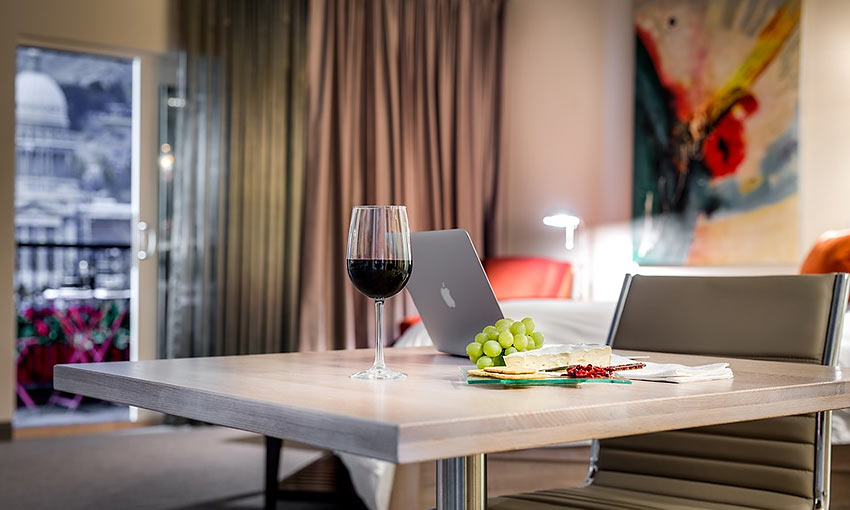
Many travelers believe their hotel rooms to be one of the safest places they can find while abroad. The hotel room becomes an immediate home away from home, giving travelers license to drop their guard as if they were in their own bedrooms. However, what they don’t realize is danger always lurks right around the corner — even in hotel rooms around the world.
A survey commissioned by The EasyLock, a British temporary door lock manufacturer, discovered over half of those surveyed knew someone who had an item stolen from their hotel room. Without realizing it until it’s too late, travelers can lose jewelry, electronics, or even travel documents without immediately realizing it.
However, as in many situations, travelers can prevent becoming a victim before they are even targeted by thieves. By breaking these five dangerous hotel habits, international adventurers can make sure they come home with all the items they came with.
Leaving Valuables in Plain Sight
Many hotel guest believe that their rooms are magically locked and sealed when the “Do Not Disturb” tag goes around the doorknob. However, even at the best hotels, the sign may not be a deterrent for a determined hotel staffer.
One of the most dangerous hotel habits is leaving valuables, such as travel documents and electronics, in plain sight after leaving the hotel room. When travelers leave their valuable items out for anyone to see, they are at risk of walking away when cleaning staff comes to take care of the room.
As one frequent traveler discovered, the maid isn’t always just looking to clean up a room — they may be looking to clean out the traveler as well. Anytime travelers leave their hotel room, be sure to pull any valuable items out of plain sight. Simply put: leaving valuables out can be an invitation for them to walk away, sometimes never to be seen again.
Not Using the Hotel Room Safe
Nearly every hotel room has an in-room safe provided as a courtesy. The code on the in-room safe is reset with every guest, meaning no two codes are the same. When traveling, the safe can be utilized for everything from electronics and valuables to a document contingency kit in case of emergency.
Another dangerous hotel habit many travelers do not adhere to is keeping their valuable items in the hotel safe. In the survey, 44 percent of travelers said they did not use the safe to keep their items secured when out of the room. While no hotel safe is entirely impenetrable, the in-room safe is an easy first line of defense from hotel room theft and keeping your items safe.
Not Using the Swing-Bar Lock While in the Hotel Room
Many travelers consider the two room entry locks — the card entry and the bolt lock — to be secure enough to protect them while in the room. However, both measures may be defeated by a hotel staff member with a bolt key and master key card, potentially leaving your valuables at risk.
Not using the swing-bar lock is not only a dangerous hotel habit but can also make the room accessible anytime a traveler is in their hotel room. When it’s time to retire for the night, always use it. The swing-bar lock is a physical bar that prevents unauthorized entry into the room when the guest is in it.
Packing More Items Than You Truly Need
As travelers see the world with more and more gadgets, the overall value of their luggage increases. Of those surveyed, the average value of their luggage and contents came to over $4,800. This creates a virtual gold mine for a would-be thief.
Although overpacking can be a dangerous habit for another reason, leaving all of those valuable items in a room is a very dangerous hotel habit. Valuable jewelry and heirlooms should always stay at home or on your person, while everything else should be locked in the hotel room safe while away.
Not Purchasing Travel Insurance Ahead of a Trip
What many travelers don’t know is that travel insurance can cover more than just trip cancellation and trip delay. A good travel insurance plan can help travelers in the worst of situations, including lost or stolen luggage. While it could be argued that not purchasing travel insurance (or having travel insurance through a credit card) makes for dangerous traveling, leaving items in a room without insurance is, in of itself, a dangerous travel habit.
No matter where an item is stolen, certain travel insurance plans may cover lost or stolen goods. Before leaving for a destination, consider purchasing a travel insurance policy to cover both the physical luggage and its contents, just in case anything is lost during a trip.
Though no traveler is perfect, knowing which dangerous hotel habits to avoid could keep modern adventures safe on the road. By breaking these five bad hotel habits, travelers can make sure their possessions stay secure, even when away.
Pickpocket-Proof Clothing: 10 Garments to Protect Your Stuff
Courtesy Sarah Greaves-Gabbadon
Nothing sours a trip like having your belongings stolen by a pickpocket. But chances are, if you travel frequently — or just happen to be unlucky — a sticky-fingered stranger will one day secretly separate you from your stuff. Since traveling sans cash, credit cards, and other valuables isn’t an option for most of us, I’ve rounded up a passel of pickpocket-proof clothing and accessories that’ll make you less of a target for thieves.
Protect Yourself with Pickpocket-Proof Clothing
While no one can guarantee that these garments are 100 percent “pickpocket-proof,” they will make it a whole lot harder for opportunistic thieves to swipe your stuff.
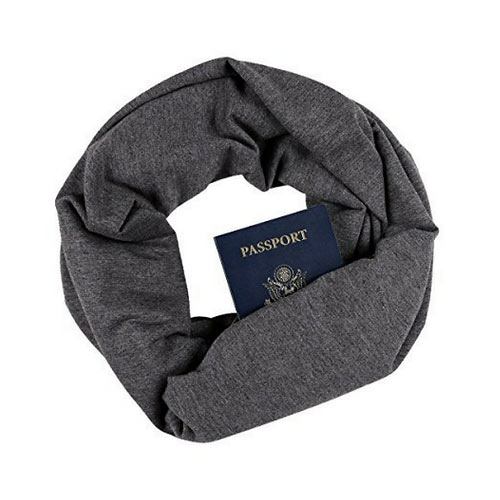 Pierron & Co.’s Infinity Scarf
Pierron & Co.’s Infinity Scarf
When you’re in flight, don’t be the person who gets up to use the bathroom and carelessly leaves their passport and money behind in the seat. Instead, tuck your valuables into the large zippered pocket in Pierron & Co’s infinity scarf. Then wrap it around your neck and hit the aisle with style and your stuff securely in tow. Buyers praise not only the fully concealed zipper but also the quality and drape of the knit fabric, which makes this pickpocket-proof clothing a particularly worthy purchase.
Clothing Arts’ Pickpocket-Proof Business Travel Shirt

I’ve seen casual men’s tops with concealed pockets, but work shirts? Not so much. So I was particularly impressed with Clothing Arts’ Pickpocket-Proof Business Travel Shirt, which has an inner zip pocket — suitable for flat items such as an ID, credit cards, and cash — hidden behind the breast pocket. A tailored but not tight fit makes it easy to wear tucked or untucked. Collar stays keep it looking sharp, and the cotton-polyester blend fabric is wrinkle-resistant and dries quickly.
SCOTTeVEST’s Boxer Briefs
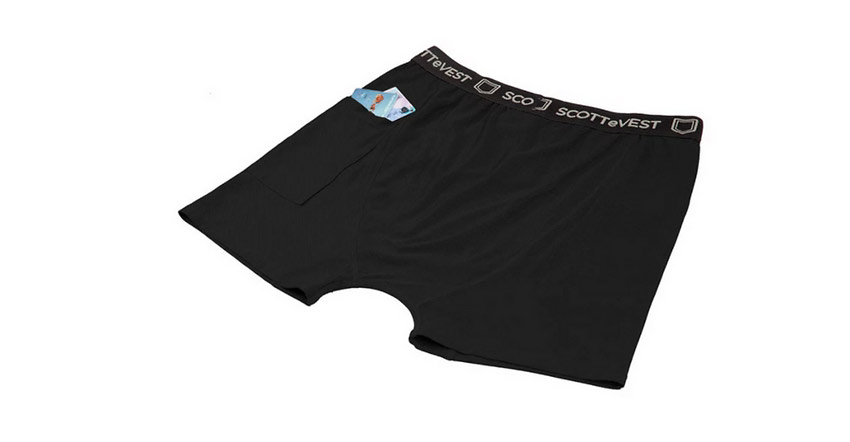
Whether they’re hitting the road or just the gym, men will appreciate SCOTTeVEST’s boxer briefs, which have pockets to hold valuables close. Made of sweat-wicking, odor-resistant, and synthetic-blend fabric with a non-constrictive fit, the shorts have an exterior front pocket for a phone, cash, or credit cards. On the opposite side is a concealed interior one that’s large enough to comfortably hold a passport.
Clothing Arts’ Travel Wrap Skirt

Admittedly, Clothing Arts’ travel wrap skirt isn’t the prettiest skirt I’ve ever seen, but what you lose in style you’ll gain in utility. With an impressive five zippered pockets (three on the side, two in the back) for secreting your stuff, this pickpocket-proof clothing has a flat-front, knee-length design that’s universally flattering, and the man-made fabric is quick-drying and water-repellent, with SPF 50 protection. Available in khaki, navy, and black, it’s a way smarter alternative to cargo shorts.
SCOTTeVEST’s TEC Hat
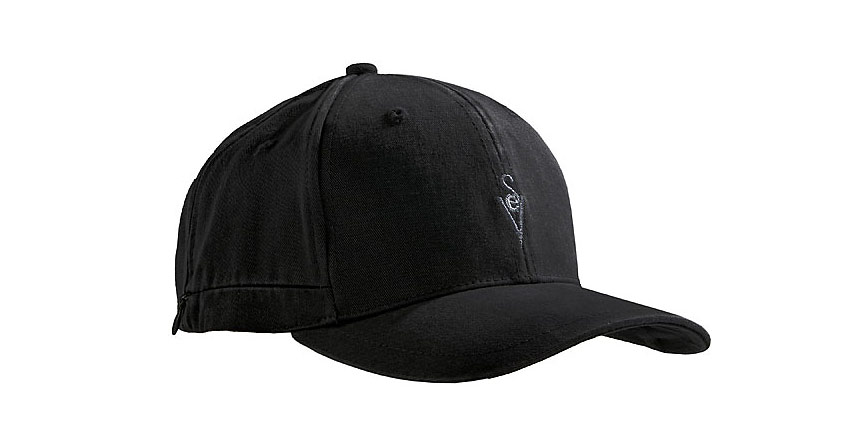
A baseball cap is pretty much the last place a pickpocket is going to try to target, which makes SCOTTeVEST’s TEC Hat all the more ingenious. From the outside the topper looks like any other, but there’s a key pocket under the brim and a side pocket with a concealed zipper for cash or a credit card. Mesh lining makes this pickpocket-proof clothing cool to wear even in steamy temps. The strap adjusts to fit most, and the cap is available in black and gray, with or without the company logo.
Lululemon’s Stash ‘n’ Run Bra

When you’re running in a new environment, you want to be focused on your surroundings, not worrying about the safety of your stuff. Lululemon’s Stash ‘n’ Run bra alleviates women’s angst with two front pockets for unobtrusively storing a room key, ID, cash, and credit cards. Made of stretchy, sweat-wicking fabric and offering medium support, it also fits the bill for other workouts. Bonus: The rear straps look cute under open-back tops.
Aday’s Throw It Higher Leggings

Travelers who don’t want to sacrifice style for security should consider Aday’s Throw It Higher Leggings. Full length and high-waisted with a firm fit, they have small zip pockets in the front, plus a hip pocket that’s large enough for a cell phone and high enough that it’s concealed under tunic-length tops. Sweat-wicking, pill-resistant technical fabric makes the leggings suitable for workouts, and fashion-forward accents (think gunmetal self-locking zips and a wet-look fabric waistband) make them equally appropriate for street wear.
Pocket Bra

If you’ve ever furtively tucked a $20 bill or credit card into your bra, you’ll immediately understand the thinking behind Pocket Bra, a lightly padded demi-cup that has pockets in its cups and along its sides, designed expressly for this purpose. Available in black and pink, the bra looks just like a regular one, complete with lace detailing at the center and sides, so it can be worn confidently with sheer tops and evening wear.
Lululemon’s ABC Pant Classic

Lululemon’s bestselling ABC Pant Classic is popular for its streamlined yet comfy “anti-ball crushing” (yes, that’s what “ABC” stands for) design. But the casual trousers — essentially a smarter, stretchy non-denim version of classic five-pocket jeans — are also a great choice for men who want to tote their passports incognito. Just tuck it into the concealed-zip back pocket of these pickpocket-proof pants, and you’re good to go.
SCOTTeVEST’s Chloe Glow
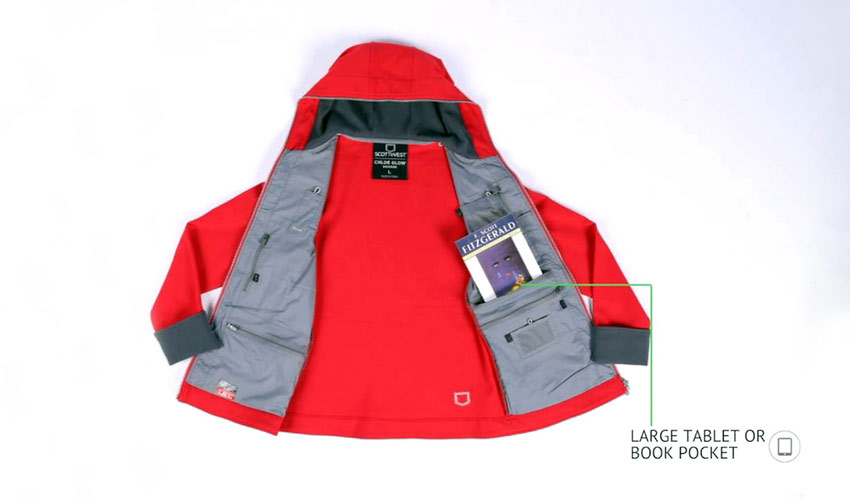
A hoodie that has a whopping 18 pockets but still looks like a regular hoodie? Sign me up for SCOTTeVEST’s Chloe Glow. Surprisingly sleek-looking, this capacious hoodie jacket has interior pockets specifically designed for not only keys, credit cards, and cash but also for glasses (with a chamois cleaning cloth attached), a tablet, and a lipstick. Its Spandex-blend fabric is moisture-wicking, and thumbholes in the sleeves keep wrists toasty and fingers free. The Chloe Glow comes in white, black, red, or blue.
Why Adventure Travel Professionals Must Care About Overtourism
Overtourism has become a buzzword of sorts in the travel and tourism industry, but understanding its complexities is the first step in addressing it. We recently shared insights about what exactly overtourism is and why it is a growing phenomenon in our professional sector. To further the discussion about how to tackle this challenge, we want to share our thoughts about why everyone working in the adventure travel industry must be proactive in preventing its further growth.
The first and most important thing to understand about overtourism is that it concerns all of us. This is not a threat relevant to a few destinations or attractions around the world. It is a rising phenomena that can strangle any place or any community. As the Adventure Travel Trade Association’s CEO, Shannon Stowell, said during his address at the 2018 Adventure Travel World Summit, “Overtourism — if it hasn’t hit you yet — there’s a good chance it’s coming to a trail or park or river or beach or mountain near you soon.”
Destinations

Many destinations early in their growth lifecycles treat excessive growth as something that concerns only more popular places. This is not so.
First, as noted in our previous article, overtourism occurs under different conditions of disparity and it does not take much to trigger them. Though a destination may seek to grow its tourism gradually, it can be suddenly overwhelmed by a heavy concentration of visitors or acts of unacceptable behavior. A Facebook post or Instagram photo can turn a quiet neighborhood (see #RueCrémieux) or secluded natural area (see #superbloom) into an overpopulated place within just days. This can happen while the rest of the destination remains underdeveloped and actually needs more growth.
Second, emerging destinations have less experience with managing tourism. If they are faced with a sudden spike in arrivals, they may suffer much more than a more mature destination that has been experiencing steady growth for a long time and has gradually built capacity in response. This is why overtourism is a challenge that should be well understood by both emerging and mature destinations.
Businesses and Entrepreneurs
Overtourism ruins valuable natural and cultural attractions, and transforms attractive destinations into undesired places to visit. The rise of anti-tourist movements in some destinations is another reason for concern. All of this can result in less business in the local tourism sector and beyond. If the excessive number of visitors makes a certain town unattractive, they will stop seeking out services in that destination. This loss of business means less revenue. Damage from overtourism can force tour operators to exclude certain sites or areas from experiences they’ve offered in the past and will require investments in new product development to fill the gaps. In fact, we know some ATTA members have started adjusting itineraries because their customers were unhappy with overcrowded areas.
Businesses and entrepreneurs should also care about overtourism because they hold the key to some of the solutions. They can alleviate the pressure by developing itineraries with a mix of popular and lesser-known attractions rather than selling programs that hit only popular, “bucket list” spots. Smart scheduling, tactical pricing, and thoughtful information and interpretation services can also contribute to improvements.
Tourism Organizations
Tourism authorities, associations, and international organizations should all be proactive in battling overtourism because it can negatively tarnish the industry’s image. The backlash toward the tourism industry as a whole is already evidenced by residents suffering in cities overrun by tourists, increasing anti-tourism sentiments, and the destruction of natural and cultural assets due to inappropriate behavior.This could result in resistance and pushback toward tourism development in the future. Residents in destinations already relying on tourism may begin to reject it and launch public initiatives against it. Residents in areas not currently benefiting from tourism but with potential to do so, may turn their backs to the option in fear that it will result in more problems than solutions.
A bad image of the industry is damaging for everyone working in it and will restrict tourism’s potential to generate extraordinary benefits to businesses, destinations, residents, and travelers. Therefore, it is important that all organizations and associations pursue proactive measures in fighting back against excessive tourism to ensure the industry keeps its image as a force for good for both people and places.
What Should the Adventure Travel Industry Do?
As a complex problem, overtourism cannot be “solved” by a single destination or a single group of people working within the adventure travel industry. There are several things we should all do in the face of this one-of-a-kind challenge requiring extensive collaboration and innovation.
The first step is to admit the problem exists and that it is a threat for the entire ecosystem. Part of recognizing its existence is understanding it can pop up anywhere overnight. It is important for both emerging and more mature destinations to understand that, with proper planning and collaborative actions, they can minimize the risks and ensure they continue developing a healthy travel economy in the future.
The next step is activating the local stakeholder network (including the public sector, private sector, non-governmental organizations, and community members) to explore preventative tactics and solutions. The challenge’s complexity and scale requires everyone’s involvement. A collaborative process can help establish a common vision about what tourism should be like and should do for the destination and its residents. The process should also help identify potential threats that might block the ability to achieve this vision. Based on a clear analysis, destination stakeholders can identify smart and creative ways to block risks and take steps toward healthy tourism that leaves a net-positive impact on places, people, businesses, and travelers. Destination managers should consider carrying capacity and explore limits of acceptable change before allowing certain developments. Tourism-related businesses can support them by becoming more mindful when designing itineraries and marketing local attractions.
This process can be complex and dynamic but it is essential for every destination. Overtourism is a complex and multifaceted challenge but it is not impossible to overcome. At the core of the battle against it is the need to keep places and communities healthy. After all, as the 2011 Sustainable Destination Report of TOTEMTOURISM notes: “Happier places to live in are also happier places to visit.”
At the ATTA, we have always believed in collaboration and bold forward thinking. We are convinced all destinations need to initiate a dialogue about what excessive tourism might mean for them today and tomorrow, and what smart approaches are available to keep it at bay. We are ready to be a partner in such dialogues and help generate solutions so we can all enjoy a healthier, less crowded future for our entire global ecosystem.
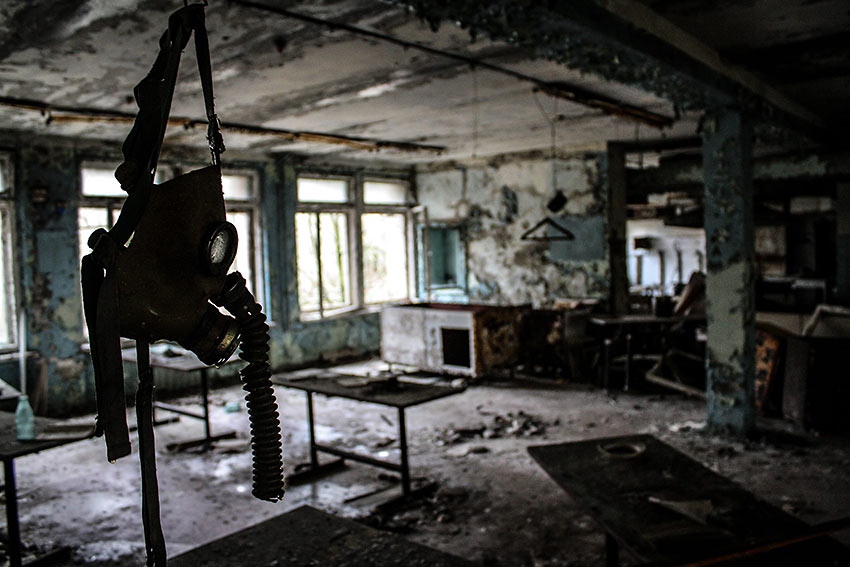
Close Encounters of the Near-Death Kind
Courtesy Richard Collett
It was a hot, humid day in Manila, and I was sat on the rooftop of my hotel, five floors high, working on my laptop and enjoying the occasional sea breeze that flew in from the bay.
I felt a faint shaking, which grew stronger and stronger until the entire roof was swaying from side to side. The entire city was shaking, but only when it stopped, did I realize that I’d just experienced my first, powerful earthquake.
Shaken from the quake, I rushed out of the building, not really knowing what to do, but understanding that I’d just had a close encounter. It had felt as if the whole building should have simply collapsed, but it didn’t.
But this wasn’t my first brush with death on the road. I’ve visited some of the world’s most disputed territories, travelled through countries prone to natural disasters, and at times, I’ve just been a complete idiot. I’ve picked up serious injuries, seen friends almost killed and accidentally ended up in war zones.
The huge 6.3 magnitude earthquake that hit Manila, on April 22 2019, had me thinking about all the close encounters I’ve had while travelling, and for the first time, I’ve decided to put the best (or worst!) of these stories into words.
These are my close encounters of the near-death kind!
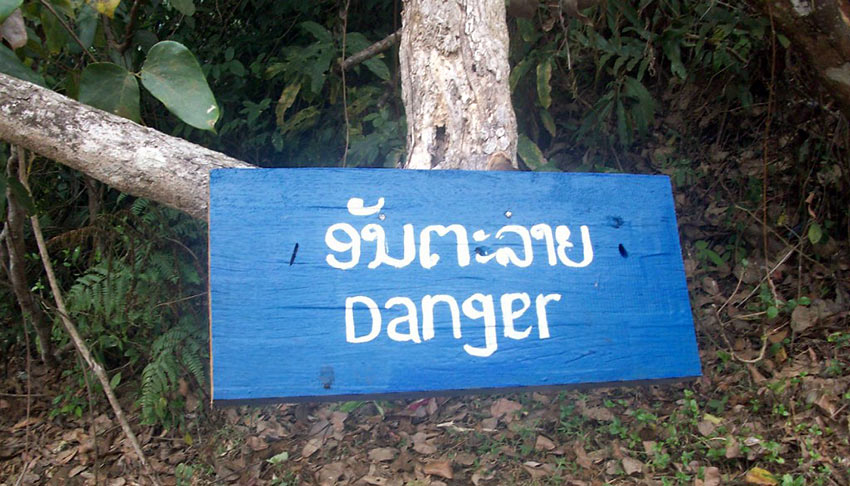
An Infection of Gangrenous Proportions
On my left leg, I have a horrible scar. It’s from a travel wound I picked up when I was motorcycling across East Timor.
The roads in East Timor are rough, and I’d decided to bike on a 125 CC scooter from Dili, the capital, all the way east to the deserted island of Jaco. On the map, it’s only around 250 kilometres, but in reality, the trip took a few days.
After hanging out with ex-guerilla fighters in the mountains, scaling a treacherous peak in the rain, and dodging death around a lake that was literally infested with hundreds of saltwater crocodiles, it was safe to say that I thought I was invincible.
But, after traversing rocky, non-existent roads for days, I was riding the bike slowly over a small bump, as the surface changed from sand to tarmac – I was barely going a kilometre an hour, but in the sand, the back wheel skidded out and I lost balance in an almost comical, slow-motion manner. I simply toppled over.
My leg grazed a few rocks, and I was left with a small cut. It was a little deeper than other scrapes I’d already picked up on the ride, but I thought little of it.
But the scrape didn’t go away. I reached Jaco Island, and then made the long journey back to Dili. The scrape was a little red now, and I’d busted the scab off once or twice swimming, but still, it didn’t look too bad.
How foolish I was. I flew from Dili, East Timor, to Bali, Indonesia, and within a week, my leg was aching. Then, overnight, it had swollen horrendously.
Okay, now it was not looking good. I’d ignored the potential infection and it had rapidly deteriorated in the tropical climate.
I was scheduled to fly to Australia, and for the few days leading up to the flight, I cleaned the wound every day and took antibiotics that my friend had leftover from a similar injury. I didn’t want to go to a doctor and pay a large excess, as I only had basic insurance, and I knew that in Australia I could see a doctor for free. The antibiotics, though should do the job, I thought.
In Melbourne, I was convinced to go straight to the doctors. This was getting worse than I’d thought. The nurse seemed shocked by the sight of my leg. The doctor asked why I hadn’t gone straight to a clinic in Bali. In fairness, at this point, my leg was three times its normal size and the wound was turning black.
It was cleaned up and I was prescribed more antibiotics. There was little to do but wait now. I should have gone to the clinic right away, of course, the doctor was right, but for the simple fear of paying an excess of believed that my own powers of medical deduction were sufficient.
Letting the wound fester, meant that I couldn’t walk properly for several weeks, and it took time to heal, leaving a hideous scar that I still have today.
If I’d have stayed in Bali longer though, and not had access to the free healthcare in Australia, I might even have lost my leg by the time I’d decided to take action. These days, I’ve learnt my lesson, and I take injuries a little bit more seriously. I also take much more comprehensive travel medical insurance, with companies such as SafetyWing, who offer a low excess and flexible monthly subscriptions that I can manage well as a Digital Nomad.
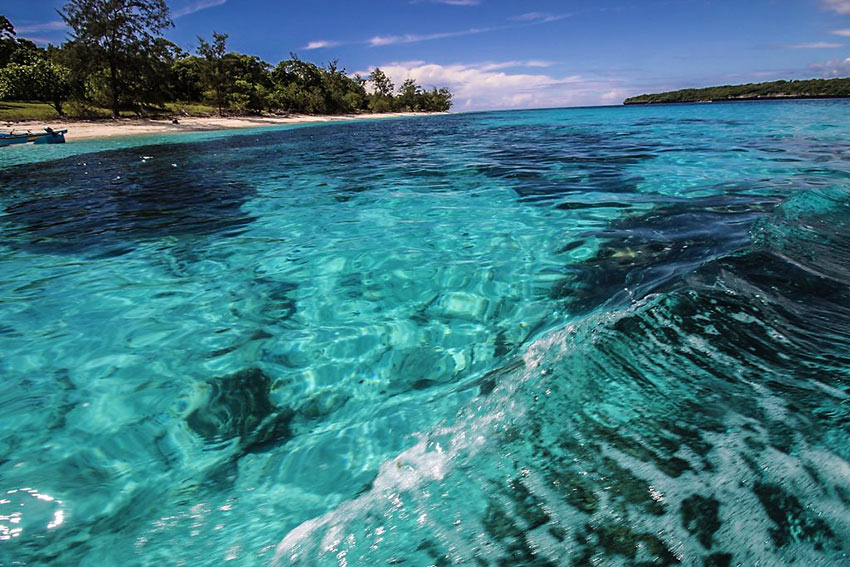
Near Death Waterfalls
Losing a leg would have been bad, but losing a friend would have been worse!
On my first backpacking trip around Southeast Asia in 2009, I was travelling through Laos with two old school mates.
We were young and reckless – now it seems, I’m old and only slightly less reckless – and we were excited to get off the beaten track and to visit the twin drop waterfall of Tad Fane.
We made our way along a bumpy track, through the forest, and ahead of us, we could see the magnificent sight of this twin drop waterfall, which falls from a staggering height of 120 metres over steep cliffs.
A rough track led down through the trees to the base of the falls, but the dirt trail was loose and warning signs at the entrance seemed to suggest that any further exploration would be hazardous to our health. Recent rainfall had made the path even more treacherous.
My friend and I decided to turn back. We weren’t in the mood for a muddy scramble, and the view from the top was spectacular enough as it was, but our third friend wanted more.
After an hour of waiting at the lookout above for him to return, we started to wonder where he was. We trekked back to the path, and carefully walked along a section of the trail until it diverged. To the left was a sheer drop, to the right the trail continued.
We decided to wait again, imaging he had taken, of course, the safe route. We went back to the start, in case he’d already made it to the top and was looking for us there. He wasn’t.
Minutes later though, he appeared. Covered in mud. Visibly shaken. In shock.
After some time, he told us what had happened. The path had given way. The sheer drop we’d seen and had reasoned that no one would try to walk down, was, in fact, the point where the trail had collapsed, taking our friend with it.
He’d hung on to vines and tree roots as rocks and mud fell around him. He’d clung on for his life, as below there was nothing but a 100-metre fall onto the rocks.
Somehow, he’d managed to reach up and eventually pull himself back up the muddy precipice.
It had been a reckless decision to carry on along the path, but despite the dangers, never had any of us thought that events would become so extreme that he would almost have fallen to his death when he began the trek to the base of the waterfall.

A Frozen Conflict That Heated Up Quickly!
I’ve travelled to many unusual destinations, and none more so than the disputed territory of Nagorno-Karabakh.
Nagorno-Karabakh is a self-declared republic in the Caucasus that’s populated by ethnic Armenians, but the land is claimed by Azerbaijan. With the collapse of the Soviet Union in the 1990s, a fierce war was waged for control over the territory, and it’s a conflict that’s never been resolved.
Both sides still face each other across trenches and barbed wire, but over time it’s become what’s known as a Frozen Conflict.
I find the idea of borders and statehood fascinating and I’d previously travelled to similar Frozen Conflict zones in the post-Soviet world, including Transnistria and Abkhazia.
In April of 2016, I made the journey from Armenia into Nagorno-Karabakh. The road leads through a tight mountain pass, where friendly soldiers checked my passport and told me to visit the Ministry of Foreign Affairs when I arrived in the capital, Stepanakert.
News can be slow to make it out of the disputed territory, and when I met with an official to arrange a permit for my stay, he thanked me for visiting his country but added that this wasn’t the best time to be in Nagorno-Karabakh.
On the border, the usually frozen conflict had suddenly erupted. There had been firing, shelling and a helicopter had even been shot down.
I was told that I couldn’t leave the city, but that I’d be safe here. Apparently, this sort of thing always happened in Nagorno-Karabakh. I stayed for a few days, but things remained tense, and locals, although appreciative of my visit, began to question why I hadn’t left yet when there were more reports from the front lines of fighting, just a few miles away from Stepanakert.
Frozen Conflicts, I had learnt, could turn hot, very quickly, and in full on Dark Tourist mode, I’d found myself right in the middle of a war.
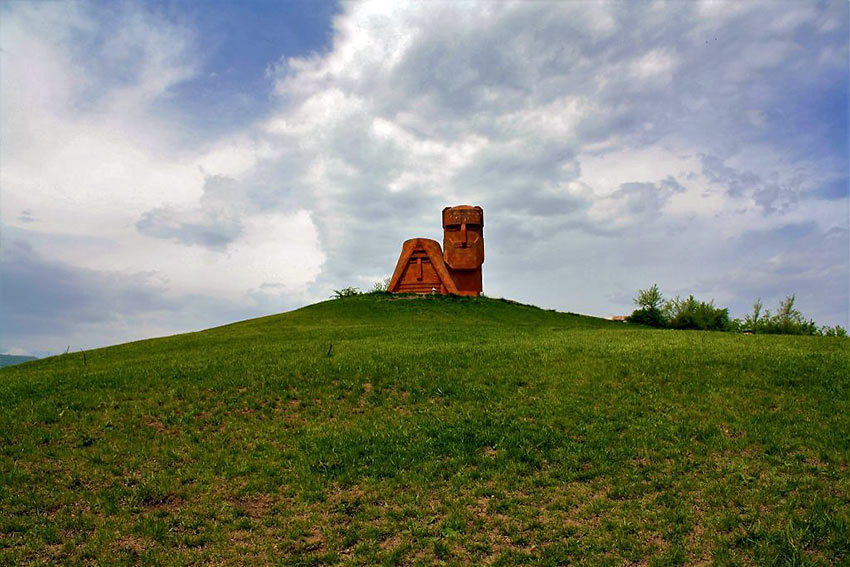
The Thrilla in Manila
On April 22, 2019, an enormous earthquake rocked Manila. The epicentre was to the north, and in the province of Pampanga, several people were killed, while the Clark airport almost collapsed.
It was a 6.3 magnitude quake, and it rocked Luzon to the core. In Manila, I felt the true power an earthquake for the first time, as for several minutes the building I was in shook and swayed. I truly feared that the worst could happen.
When the shaking subsided, I realised that I had no idea what to do in an earthquake. I raced downstairs and onto the street, but this was Manila, and there are pylons, wires, trees and buildings everywhere. Nowhere seemed safe.
Luckily, there were no large aftershocks. Through the day though, my friends in the city sent me messages telling me how their office buildings shook, how the floor in front of them had cracked open or windows had shattered.
In a contemplative mood, I realised that this had a been close encounter. The huge earthquake had shaken me to the core as much as it had shaken the city, but luckily, in Manila at least, the damage had somehow been only superficial.
Since the earthquake, I’ve educated myself on what to do should I experience another. But I hope that I won’t have to put any disaster plan into action any time soon!
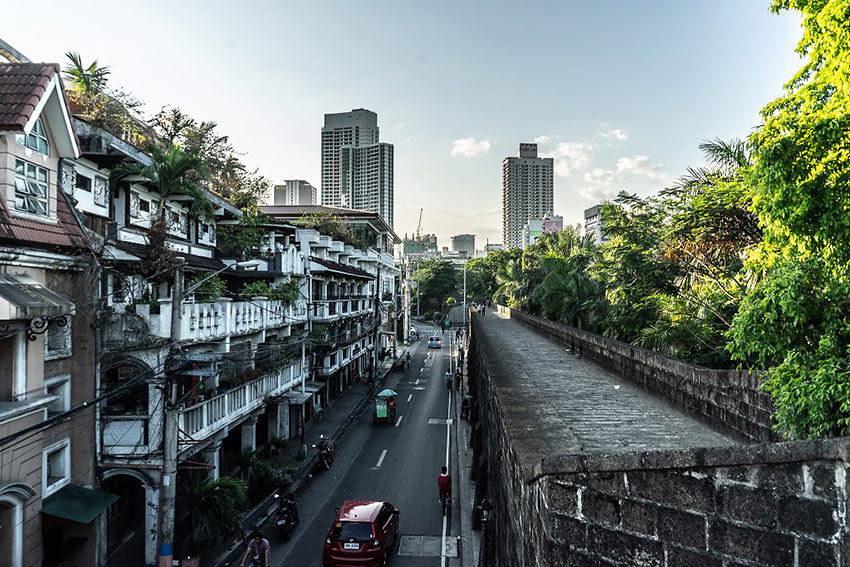
Safe Travels
Travelling has its risks, but I’m not trying to be a scaremonger in this article.
Anything can happen in your home country too, or in destinations that are generally perceived to be safe.
I love travelling to off beat destinations and experiencing new things, overcoming challenges and fears, but from my travels, I’ve also learnt that it pays to be prepared.
I check the news now before I head anywhere new or potentially unstable, but only the worst dangers would make me change my plans.
Most of all though, after years of travelling I’ve realised that I’m not invincible, that I very well could have lost my leg to an infection, and that one day, something even worse could happen to me.
That doesn’t make me fear travelling – rather I see it as the challenge of travel – but it does ensure that I have adequate travel medical insurance, both for my gear and for myself.
I encourage everyone to travel if they can. I encourage people to uncover the strange and to see the unusual.
I also encourage people to be prepared, to keep up to date with political events, and to be covered in case of accidents or injuries because life is unpredictable – and that goes for being home or abroad!.
For me though, it’s the unpredictability that is the best part of life and travel.








